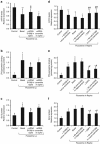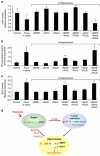Raphe-mediated signals control the hippocampal response to SRI antidepressants via miR-16
- PMID: 22833211
- PMCID: PMC3309472
- DOI: 10.1038/tp.2011.54
Raphe-mediated signals control the hippocampal response to SRI antidepressants via miR-16
Abstract
Serotonin reuptake inhibitor (SRI) antidepressants such as fluoxetine (Prozac), promote hippocampal neurogenesis. They also increase the levels of the bcl-2 protein, whose overexpression in transgenic mice enhances adult hippocampal neurogenesis. However, the mechanisms underlying SRI-mediated neurogenesis are unclear. Recently, we identified the microRNA miR-16 as an important effector of SRI antidepressant action in serotonergic raphe and noradrenergic locus coeruleus (LC). We show here that miR-16 mediates adult neurogenesis in the mouse hippocampus. Fluoxetine, acting on serotonergic raphe neurons, decreases the amount of miR-16 in the hippocampus, which in turn increases the levels of the serotonin transporter (SERT), the target of SRI, and that of bcl-2 and the number of cells positive for Doublecortin, a marker of neuronal maturation. Neutralization of miR-16 in the hippocampus further exerts an antidepressant-like effect in behavioral tests. The fluoxetine-induced hippocampal response is relayed, in part, by the neurotrophic factor S100β, secreted by raphe and acting via the LC. Fluoxetine-exposed serotonergic neurons also secrete brain-derived neurotrophic factor, Wnt2 and 15-Deoxy-delta12,14-prostaglandin J2. These molecules are unable to mimic on their own the action of fluoxetine and we show that they act synergistically to regulate miR-16 at the hippocampus. Of note, these signaling molecules are increased in the cerebrospinal fluid of depressed patients upon fluoxetine treatment. Thus, our results demonstrate that miR-16 mediates the action of fluoxetine by acting as a micromanager of hippocampal neurogenesis. They further clarify the signals and the pathways involved in the hippocampal response to fluoxetine, which may help refine therapeutic strategies to alleviate depressive disorders.
Figures




Similar articles
-
miR-16 targets the serotonin transporter: a new facet for adaptive responses to antidepressants.Science. 2010 Sep 17;329(5998):1537-41. doi: 10.1126/science.1193692. Science. 2010. PMID: 20847275
-
The role of noradrenergic tone in the dorsal raphe nucleus of the mouse in the acute behavioral effects of antidepressant drugs.Eur Neuropsychopharmacol. 2007 Feb;17(3):215-26. doi: 10.1016/j.euroneuro.2006.06.012. Epub 2006 Sep 25. Eur Neuropsychopharmacol. 2007. PMID: 16997535
-
Fluoxetine effects on behavior and adult hippocampal neurogenesis in female C57BL/6J mice across the estrous cycle.Psychopharmacology (Berl). 2020 May;237(5):1281-1290. doi: 10.1007/s00213-020-05456-5. Epub 2020 Jan 21. Psychopharmacology (Berl). 2020. PMID: 31965254 Free PMC article.
-
Behavioral and serotonergic consequences of decreasing or increasing hippocampus brain-derived neurotrophic factor protein levels in mice.Neuropharmacology. 2008 Nov;55(6):1006-14. doi: 10.1016/j.neuropharm.2008.08.001. Epub 2008 Aug 12. Neuropharmacology. 2008. PMID: 18761360 Review.
-
Depression and adult neurogenesis: Positive effects of the antidepressant fluoxetine and of physical exercise.Brain Res Bull. 2018 Oct;143:181-193. doi: 10.1016/j.brainresbull.2018.09.002. Epub 2018 Sep 17. Brain Res Bull. 2018. PMID: 30236533 Review.
Cited by
-
Reciprocal MicroRNA Expression in Mesocortical Circuit and Its Interplay with Serotonin Transporter Define Resilient Rats in the Chronic Mild Stress.Mol Neurobiol. 2017 Oct;54(8):5741-5751. doi: 10.1007/s12035-016-0107-9. Epub 2016 Sep 22. Mol Neurobiol. 2017. PMID: 27660265 Free PMC article.
-
MicroRNA-34a Regulates the Depression-like Behavior in Mice by Modulating the Expression of Target Genes in the Dorsal Raphè.Mol Neurobiol. 2020 Feb;57(2):823-836. doi: 10.1007/s12035-019-01750-2. Epub 2019 Sep 3. Mol Neurobiol. 2020. PMID: 31482401
-
Wnt signaling networks in autism spectrum disorder and intellectual disability.J Neurodev Disord. 2016 Dec 5;8:45. doi: 10.1186/s11689-016-9176-3. eCollection 2016. J Neurodev Disord. 2016. PMID: 27980692 Free PMC article. Review.
-
Epigenetic mechanisms of rapid-acting antidepressants.Transl Psychiatry. 2024 Sep 4;14(1):359. doi: 10.1038/s41398-024-03055-y. Transl Psychiatry. 2024. PMID: 39231927 Free PMC article. Review.
-
Role of microRNAs in stroke and poststroke depression.ScientificWorldJournal. 2013 Dec 2;2013:459692. doi: 10.1155/2013/459692. ScientificWorldJournal. 2013. PMID: 24363618 Free PMC article. Review.
References
-
- Santarelli L, Saxe M, Gross C, Surget A, Battaglia F, Dulawa S, et al. Requirement of hippocampal neurogenesis for the behavioral effects of antidepressants. Science. 2003;301:805–809. - PubMed
-
- Duman RS. Depression: a case of neuronal life and death. Biol Psychiatry. 2004;56:140–145. - PubMed
-
- Drzyzga LR, Marcinowska A, Obuchowicz E. Antiapoptotic and neurotrophic effects of antidepressants: a review of clinical and experimental studies. Brain Res Bull. 2009;79:248–257. - PubMed
-
- Macqueen G, Frodl T. The hippocampus in major depression: evidence for the convergence of the bench and bedside in psychiatric research. Mol Psychiatry. 2010;16:252–264. - PubMed
Publication types
MeSH terms
Substances
LinkOut - more resources
Full Text Sources

